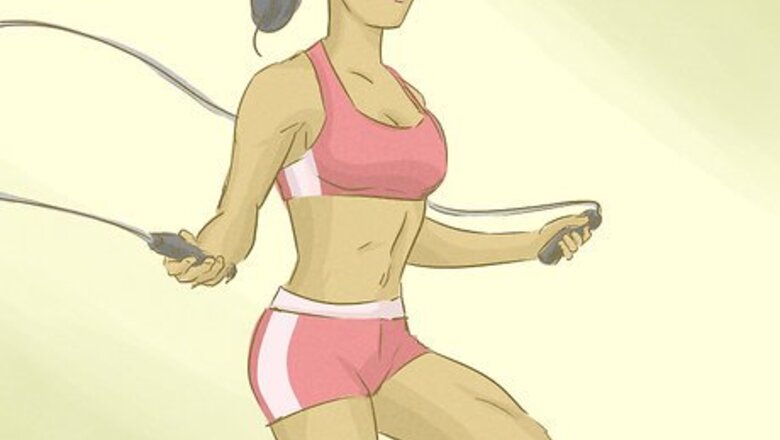
views
X
Research source
Warming up incorrectly, however, can be a detriment to your workout, tire you out, and fail to protect you from further injuries such as twists or sprains.[2]
X
Research source
By combining dynamic exercises and performing warm-up sets in the correct way, you can improve your weight lifting results.
Doing a Dynamic Warm up
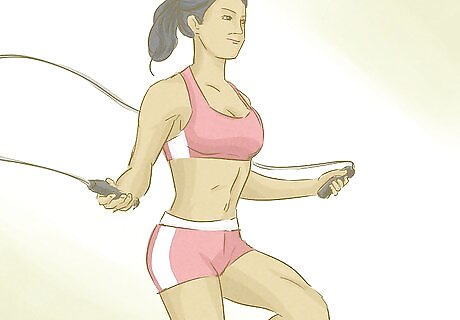
Jump rope for two to three minutes. Jumping rope before you lift weights can increase your blood flow and prepares your heart and nervous system for physical activity. It's important that you don't jump rope for more than three minutes because you don't want to deplete your glycogen stores and reduce your energy before you lift. Find a space like on a padded floor to jump rope, so you don't put any unnecessary stress on your ankles. A jump rope can often be purchased for under $5. Get a jump rope that is nine feet or longer if you are over six feet tall. Jumping rope will increase your blood flow.
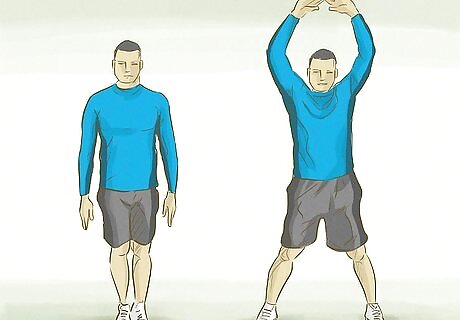
Perform 50 jumping jacks. Jumping jacks work out your legs, core, and heart. Start by standing with your feet together, hands by your side. Jump while pushing your feet apart and bringing your hands together straight over your head. Return to the start position by jumping. Continue to do this 50 times or enough times to build a sweat but not get fatigued. If you tire yourself out too much before having to lift, lactic acid will build up in your muscles and make your weight lifting routine less efficient. You don't want to tire yourself out before you start to lift, so if 50 jumping jacks get you tired, consider reducing the amount. EXPERT TIP Laila Ajani Laila Ajani Fitness Trainer Laila Ajani is a Fitness Trainer and founder of Push Personal Fitness, a personal training organization based in the San Francisco Bay Area. With over 10 years as a trainer and exercise specialist, Laila has expertise in competitive athletics (gymnastics, powerlifting, and tennis), personal training, distance running, and Olympic lifting. Laila is certified by the National Strength & Conditioning Association (NSCA), USA Powerlifting (USAPL), and she is a Corrective Exercise Specialist (CES). Laila Ajani Laila Ajani Fitness Trainer Keep your warmup light and easy. If you're doing cardio to warm up for lifting, just spend about 5-15 minutes doing some type of cardio. Don't burn too much energy—just try to get your heart rate up and your body warm.

Do Lunges five times on each leg. Lunges help stretch out your hip flexors and activate your legs, glutes, and hip muscles. To perform a lunge, step forward with one leg and lower your hips until both legs are bent at a 90-degree angle. Keep your back straight and shoulders back. Your front knee should be above your ankle, and not pushed out too far, and your back knee should not be touching the ground. Come back to a standing position and alternate with each leg. Twisting your hips at the end of a lunge can also help stretch your upper and middle back. Lunges are great when you are warming up for exercises like the deadlift.
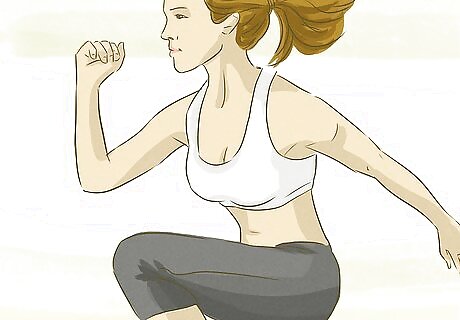
Perform a minute of high knees and high lateral knees. High knees will improve flexibility and power in lower parts of your body like your hips and legs. To do high knees, start in the standing position and lift and bend your leg to your hip, then return to the standing position. Alternate legs and pump your arms while you perform the exercise. This warm up will prepare you for exercises like squats or the leg press. High knees and lateral knees work out your quadriceps, hamstrings, glutes, and abductors.
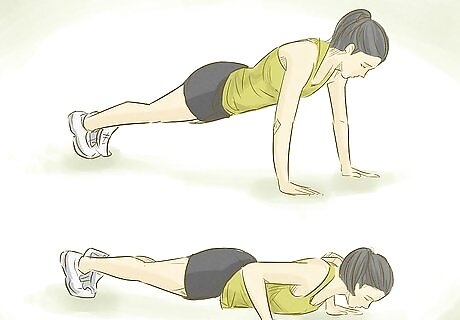
Perform 10 to 20 pushups. Pushups warm up your chest, shoulders, and triceps. To do a push up, place your hands flat on the ground, directly under your shoulders. Flatten your back so that your weight is centralized on glutes and hamstrings. Lower your body by bending your elbows inwards and using your arms to lower you to the ground in a steady, controlled fashion. Push back up and repeat the steps. A standard pushup uses 50%-60% of your body weight as resistance. Pushups are great warm ups for upper body exercises like the benchpress or curls.
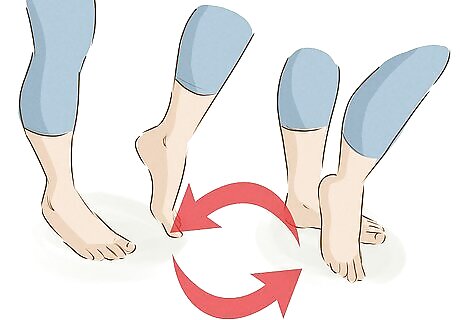
Perform ten rocking ankle mobilizations. Protecting your ankles is necessary for leg exercises and standing lifts, such as the deadlift. To carry out a rocking ankle mobilization, start in a push-up position. Push your hips up higher above your torso so that your body looks pitched. Place one foot planted on the ground while resting your other foot on the planted foot's ankle. Rock back and forth so that your heel touches the floor then lifts off of it. Switch legs and repeat the process. You may have to perform more reps if one ankle is tighter than the other. It's important to have stable ankles for exercises like the leg press and deadlift.

Talk to a personal trainer. Hundreds of other exercises exist and can help aid you in your weight training and help prevent potential injury. A personal trainer can help you target the parts of your body that you want to develop. They may also be able to assist you in other things like your diet. Other popular weight training exercises used to warm up include foam roll exercises, leg swings, arm swings, arm circles, spiderman steps, and hip extensions.
Performing Warm up Sets

Rest for 45-60 seconds in between sets. Resting in between sets will allow your body to adjust and decrease the amount of fatigue that you'll feel. It's important that you keep up a decent tempo, but that you also don't tire yourself out. Test out different times and determine the right amount of time for your workout. On your last lift, you should give yourself an adequate cooldown period of a minute or two before starting your actual routine.
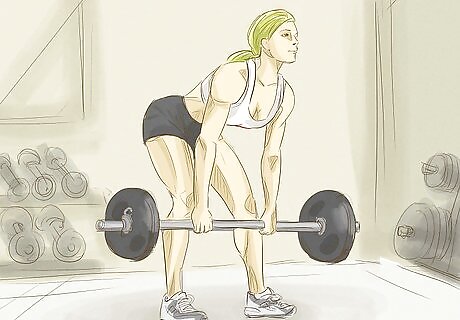
Lift the bar ten times. Determine the type of routine or muscles that you are going to work out and do a very light warm-up of those muscle groups by performing the exercise at a lightweight. For example, if you are going to use a bench press, use the bar to warm up. Do not start off a high rate or repetitions that exceed eight or you may tire yourself out before you can start your real weight routine. The only exception to this rule is if you are performing deadlifts. At many gyms, you will use a squat rack to elevate the level of your barbell. If you don't have access to that, you can even use 2 benches to suspend the bar rather than trying to lift more than you can. If you are using barbells, use a low weight like 10 lbs (4.5 kgs) to start. EXPERT TIP Laila Ajani Laila Ajani Fitness Trainer Laila Ajani is a Fitness Trainer and founder of Push Personal Fitness, a personal training organization based in the San Francisco Bay Area. With over 10 years as a trainer and exercise specialist, Laila has expertise in competitive athletics (gymnastics, powerlifting, and tennis), personal training, distance running, and Olympic lifting. Laila is certified by the National Strength & Conditioning Association (NSCA), USA Powerlifting (USAPL), and she is a Corrective Exercise Specialist (CES). Laila Ajani Laila Ajani Fitness Trainer Our Expert Agrees: If you don't want to do cardio to warm up, try starting with a very light lift, then increase your weight in slow, evenly-spaced jumps. For instance, if you're planning to work up to 100 pounds, you might lift 40 pounds for your first set. Then, you might go up to 60, 80, and finally 100 pounds.
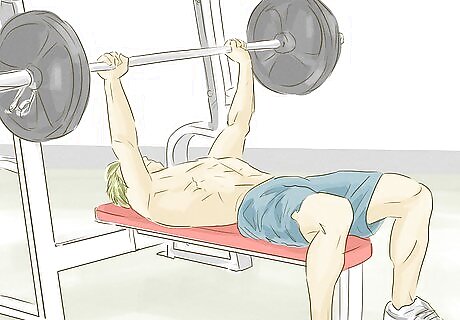
Load 55%-60% of your workout weight and do eight more reps. Load 55% to 60% of your workout weight onto your bar or leg press. At this point, your workout should still be somewhat explosive with the lower weight. Increasing the amount of weight and decreasing the number of reps is known as "ramping up." Doing so will allow your nervous system and your muscles to adjust before you begin your actual workout. Ramping up also increases the range of motion of your muscles and joints and can decrease the chance of injury. Exercises like the kettle ball swing, seated box jumps, and medicine ball reactive throws can help with your explosiveness.
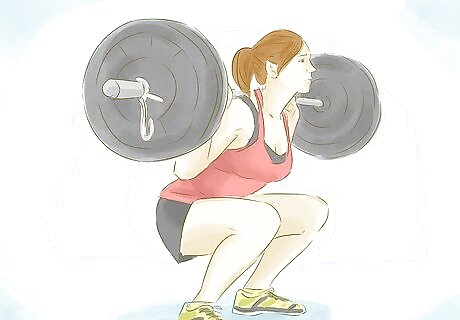
Lift 70% -75% of your workout weight five times. Continue to increase the amount of weight onto your bar. Remember that at this point you should not be tired because these are just the warm up lifts. If you do find your muscles to be excessively tired, consider reducing the weight for your warm up routine.
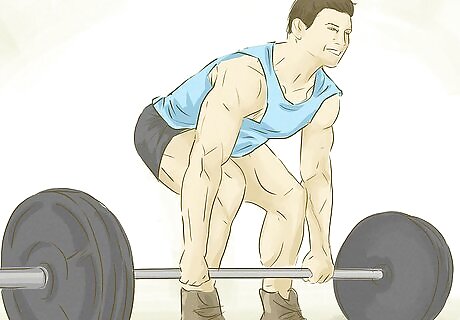
Lift 80% 85% of your workout weight three times. Once you get to your fourth set, you should start to lift with a moderate tempo. Typically, the lighter the load, the quicker your pace needs to be for your lifts to be effective in warming you up.
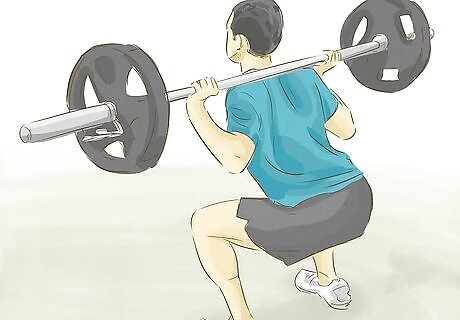
Lift your workout weight once. Once you do this, you've finished your warm up routine and can start working with your actual weight. Make sure that you don't feel fatigued or tired. The point of the warm up is to acclimate your body to lifting so that you can lift heavier weight for a longer period of time during your actual workout.

Determine your one rep max. Figuring out your one rep max will help you ramp up because you'll be able to calculate how much weight you should lift during a warm-up. To determine your one rep max, divide the max weight you can lift by the number of reps you can do as a percent. For instance, if you can lift 250 lbs (113.39 kg) for eight reps, then you divide 250 (113.39 kg) by .80 to get 312.5 (141.75 kg) one rep max. You can also determine your exact one rep max by using an online calculator and plugging in the amount of weight and reps you can usually do in a regular workout. For example, if you can lift 150 lbs (68 kgs) 10 times, your one rep max would be 200 lbs (90.7 kgs). There are also apps available that can help you determine your one rep max. Use these instead of continually lifting with increased weight to the point of total failure, as this can lead to injury.




















Comments
0 comment